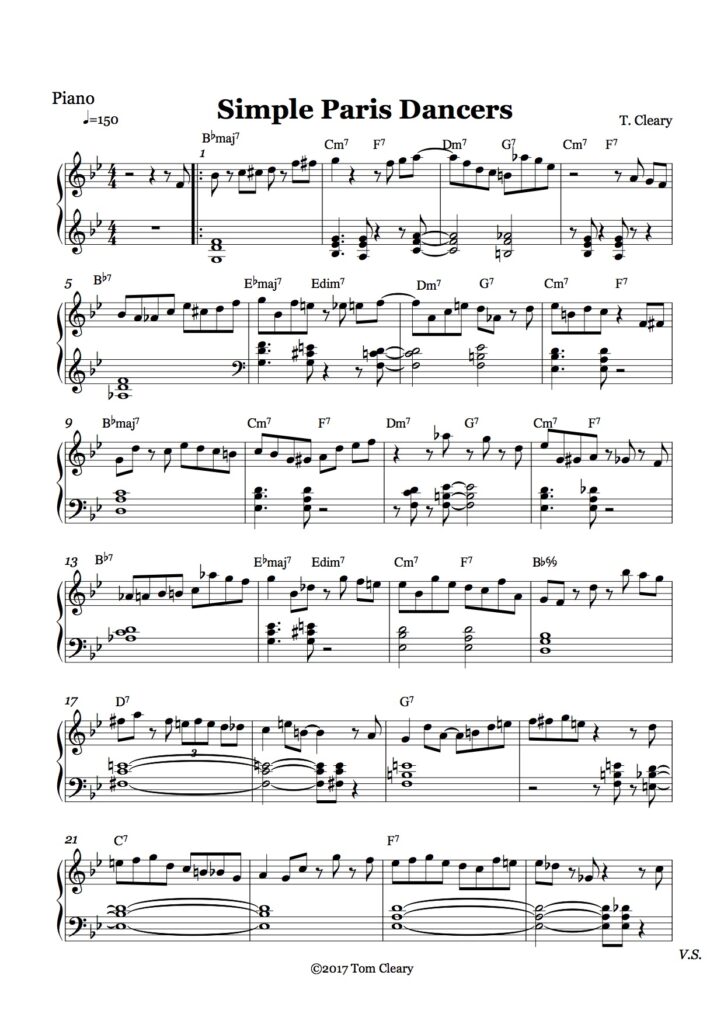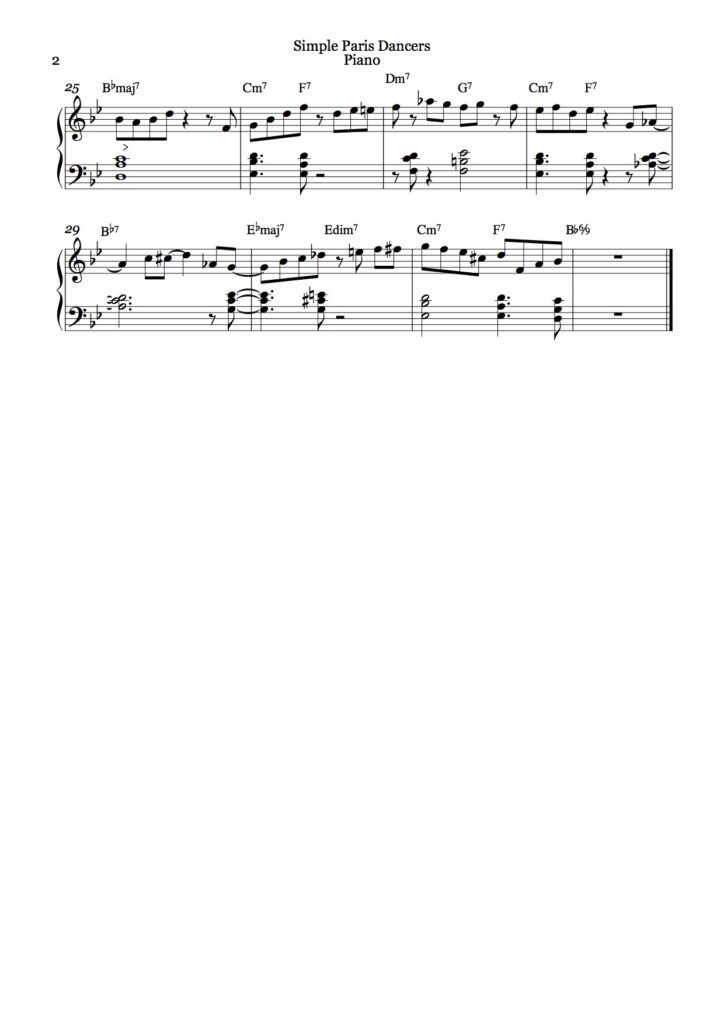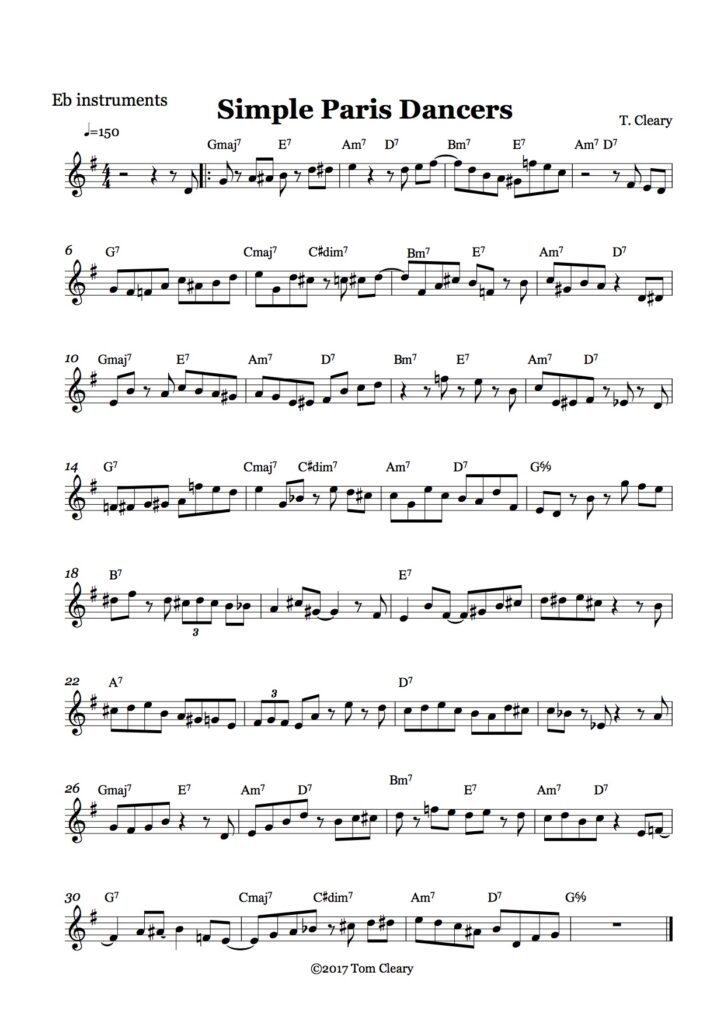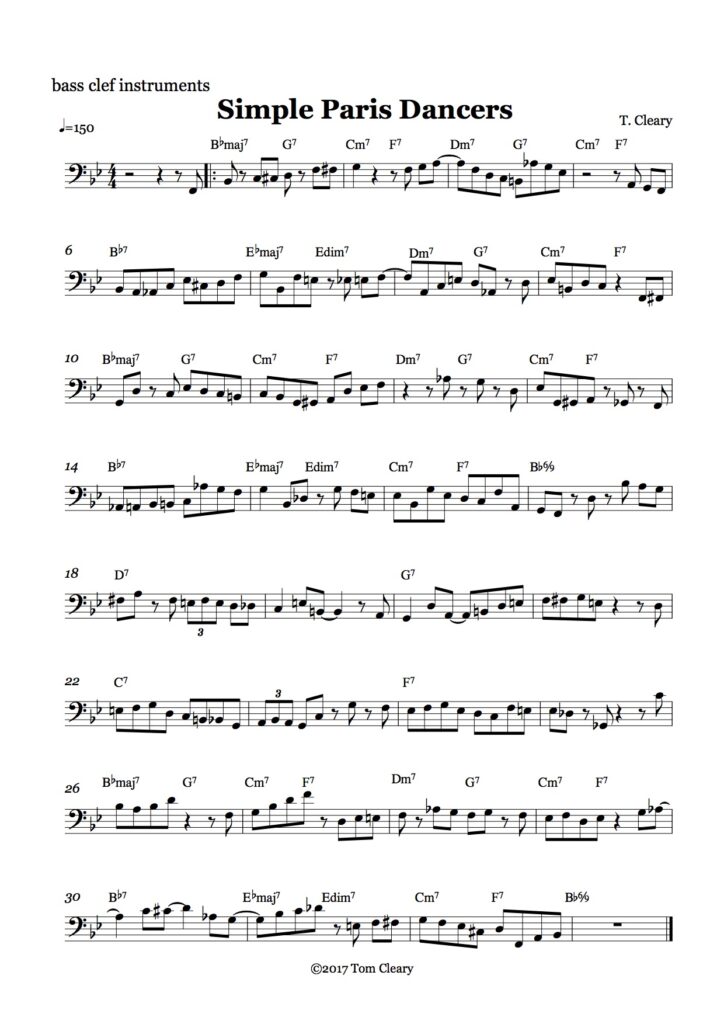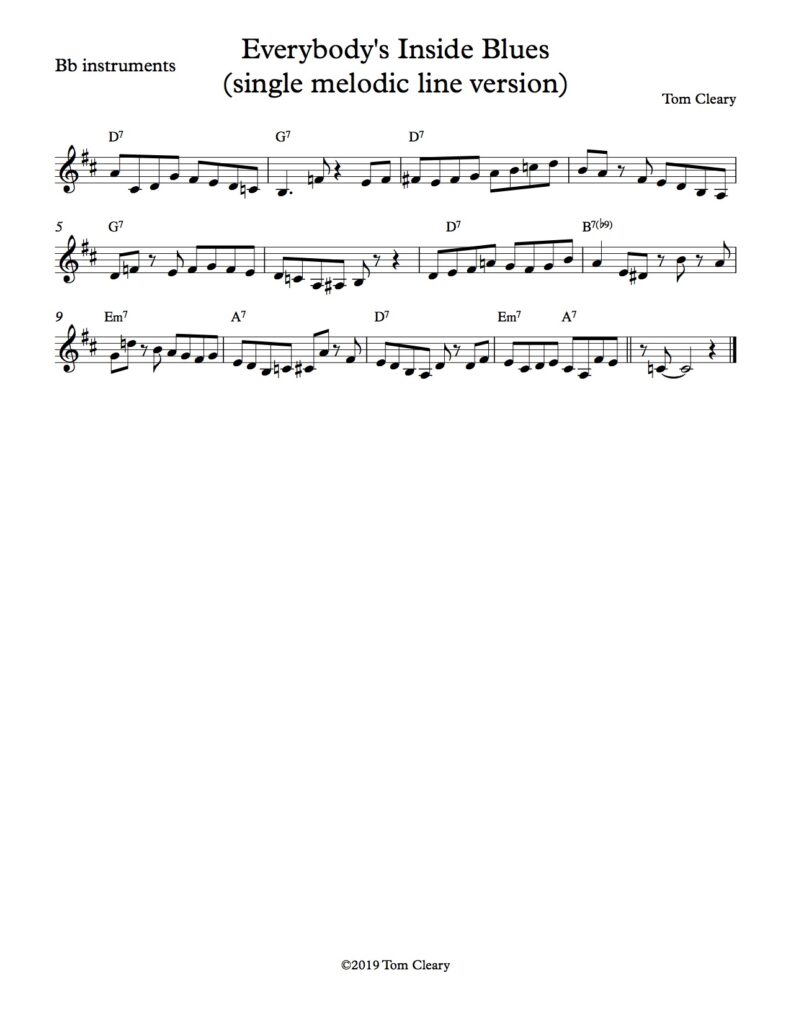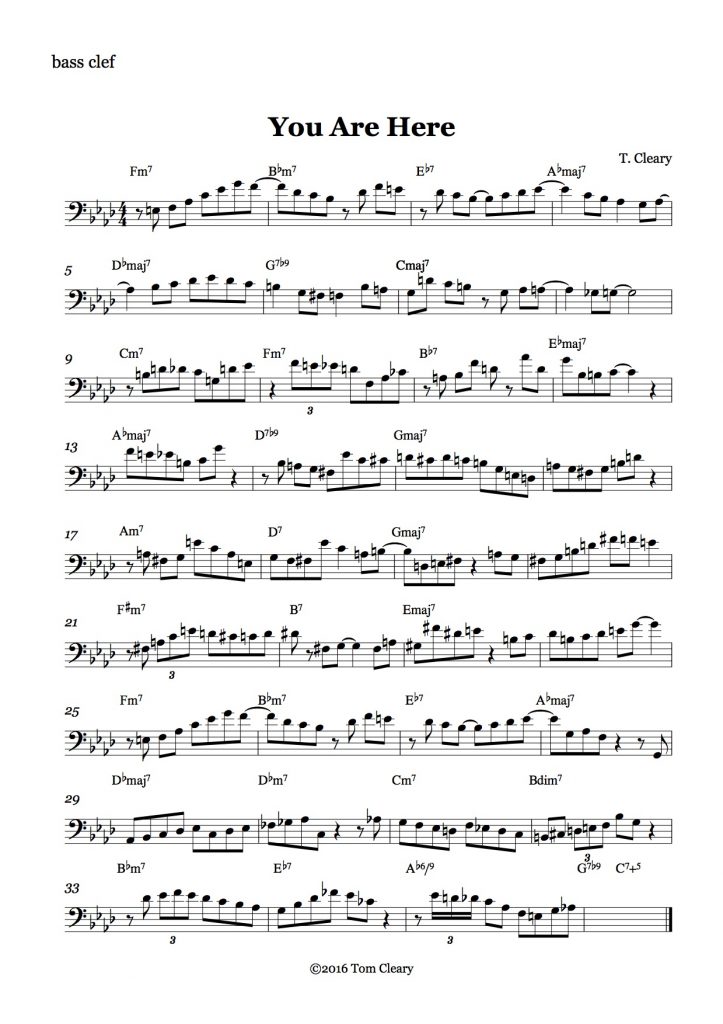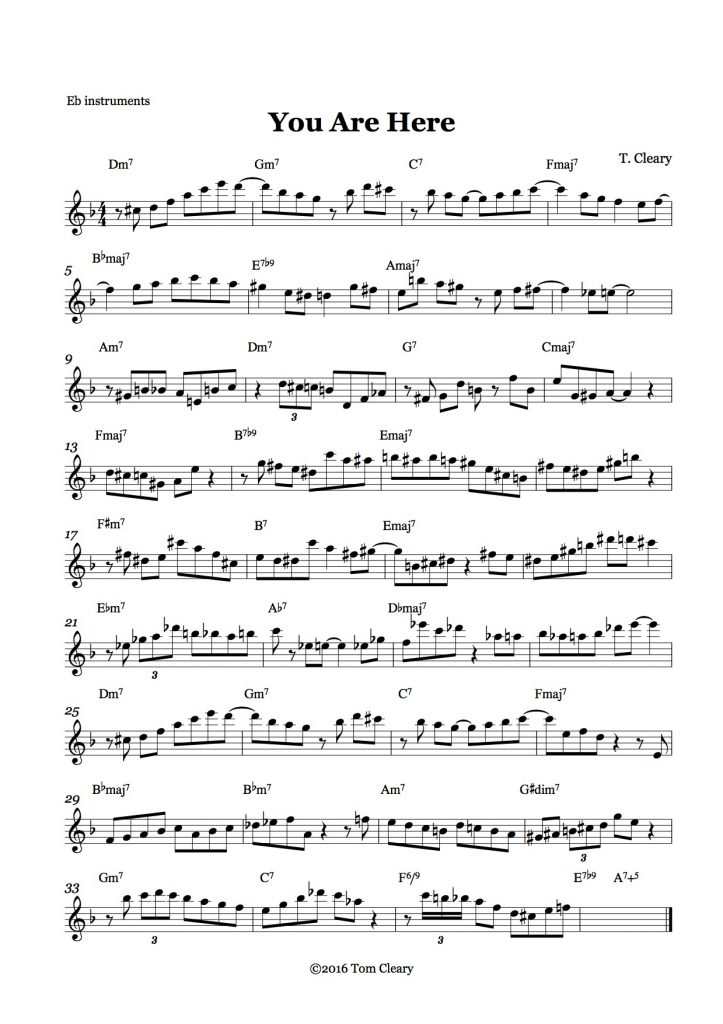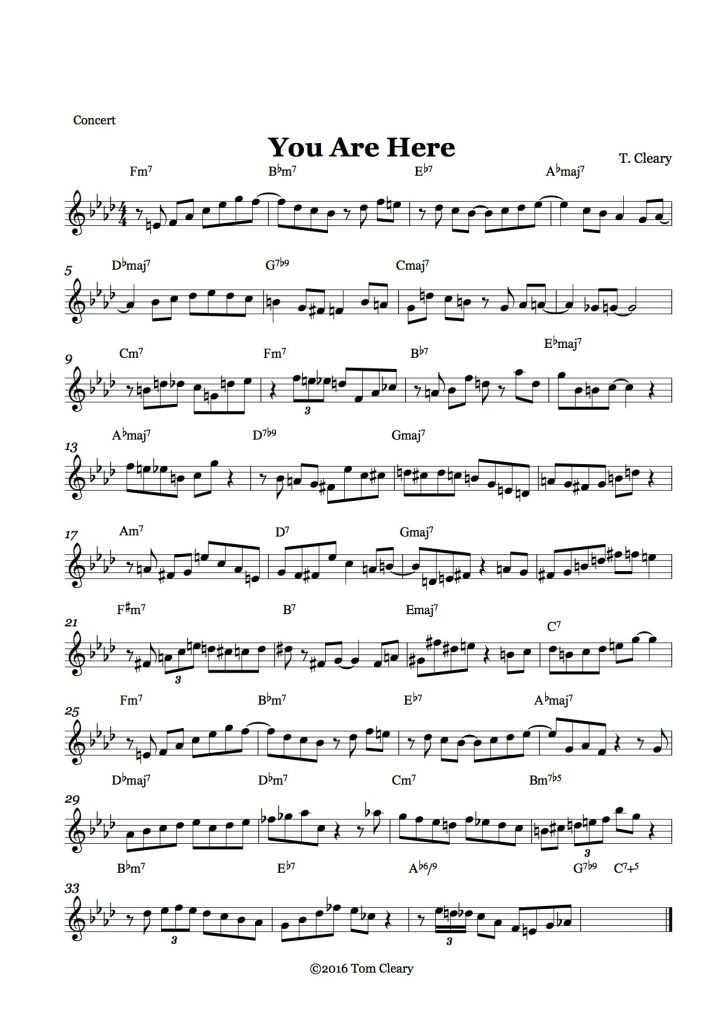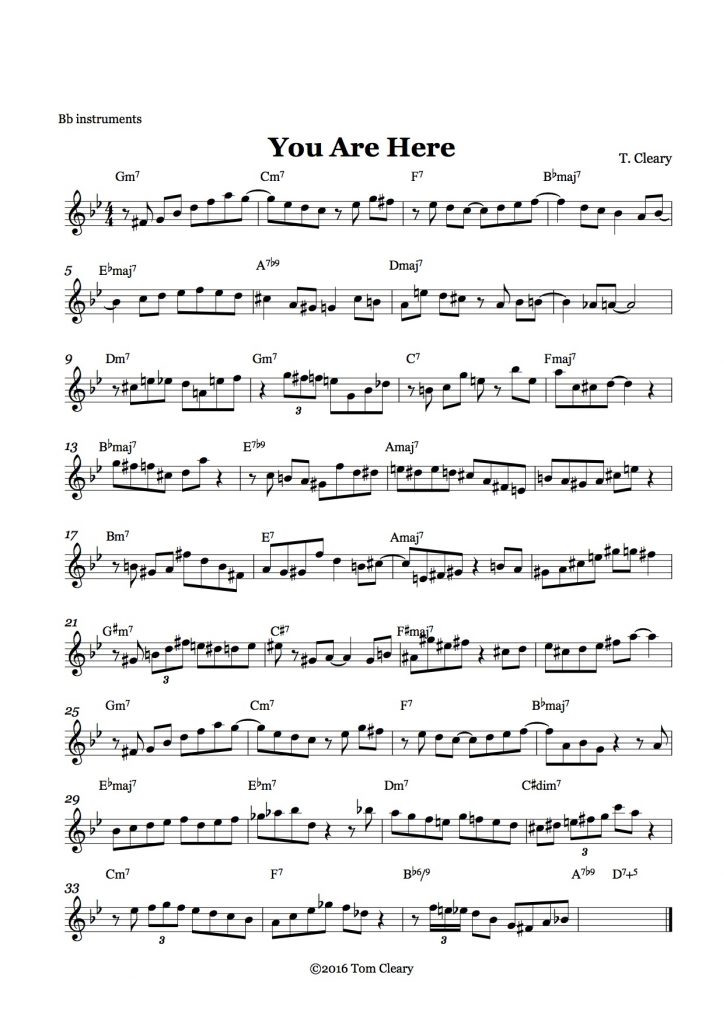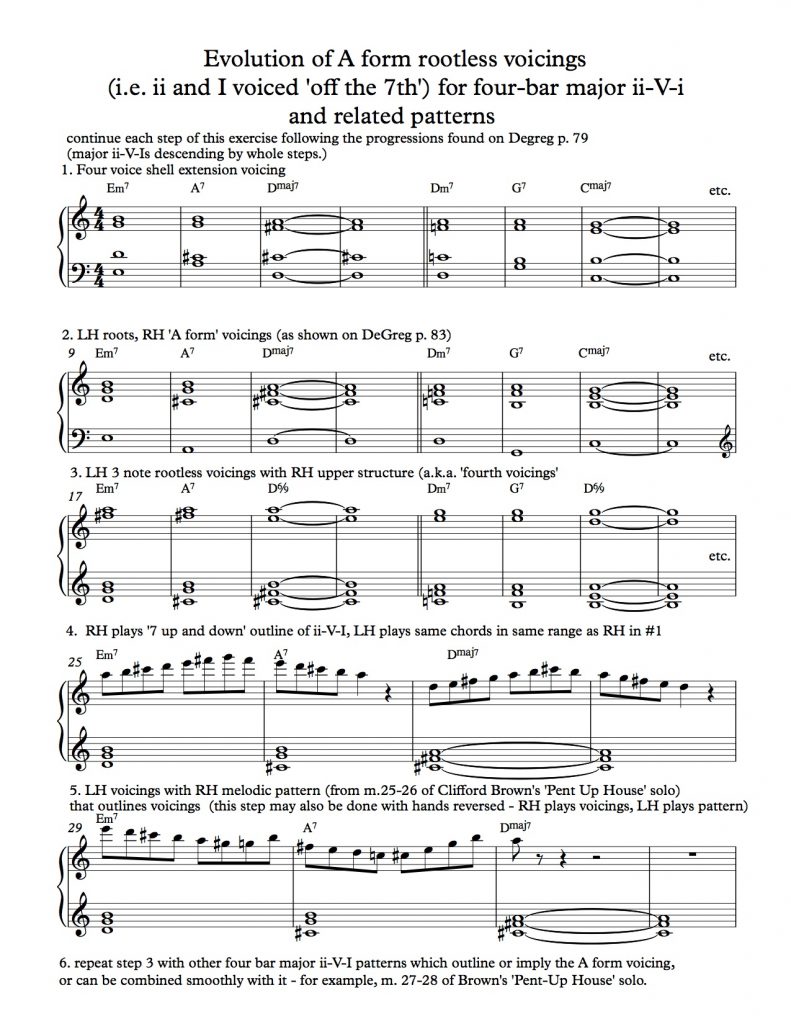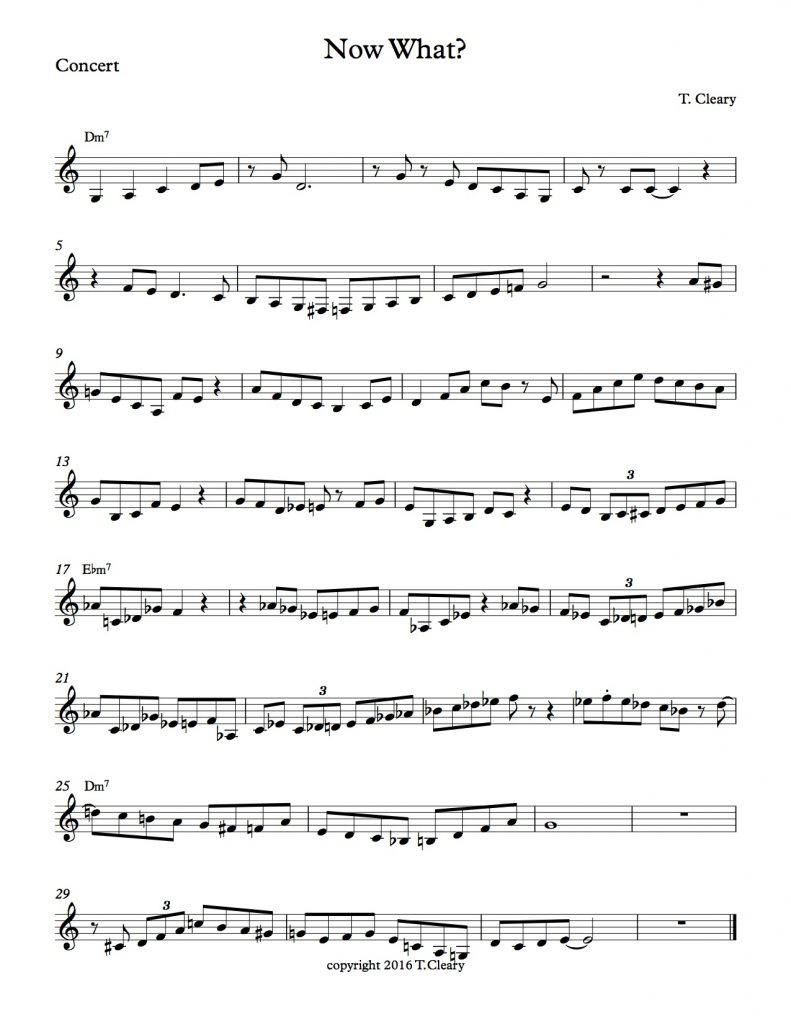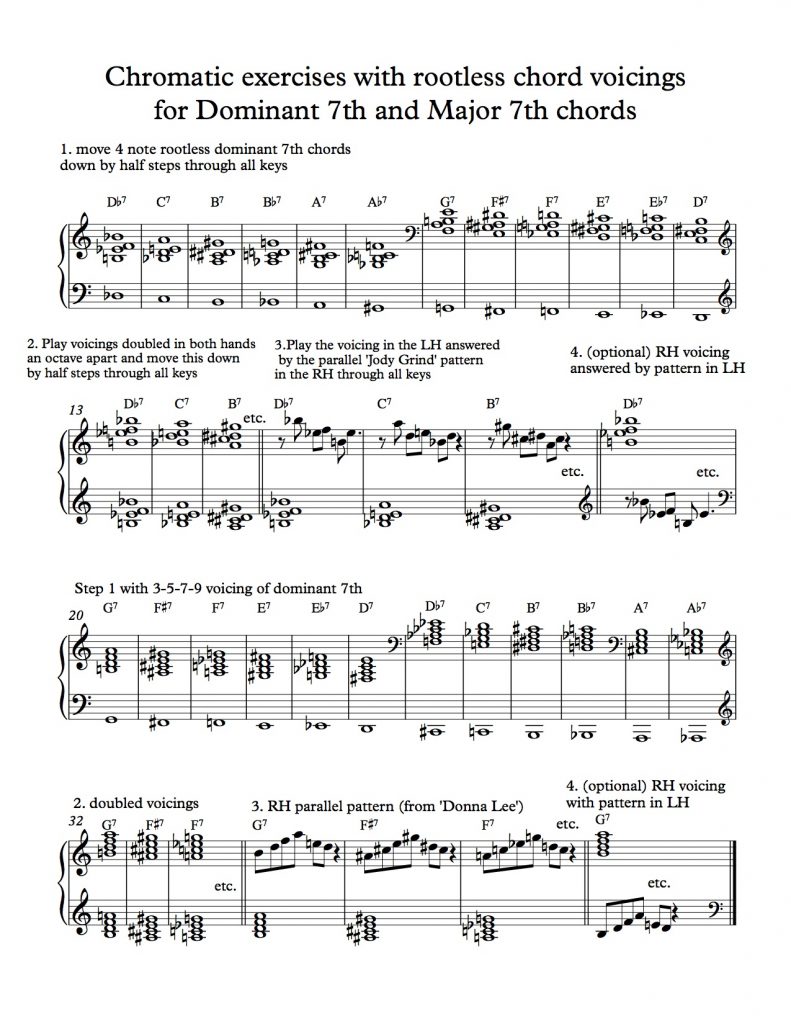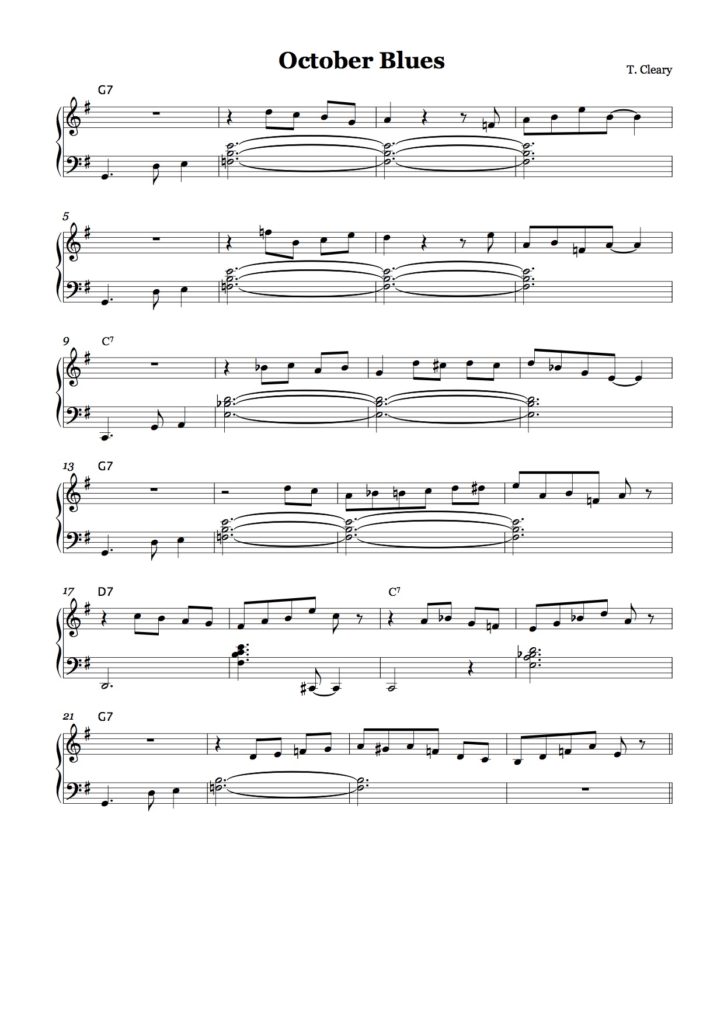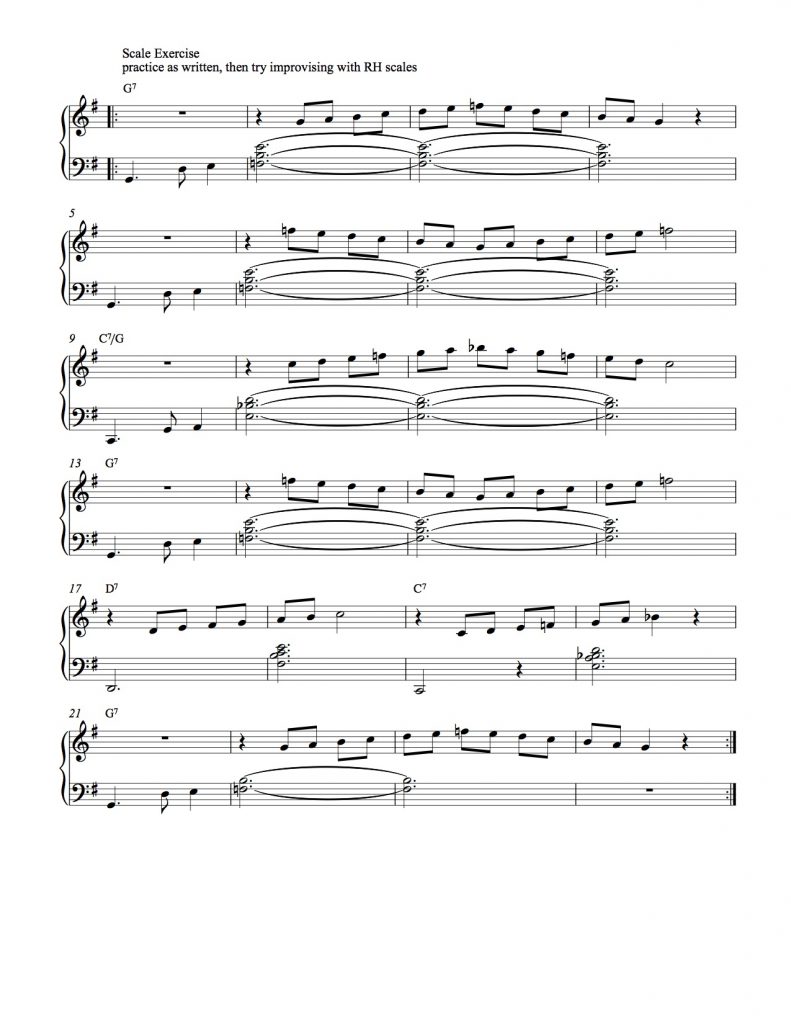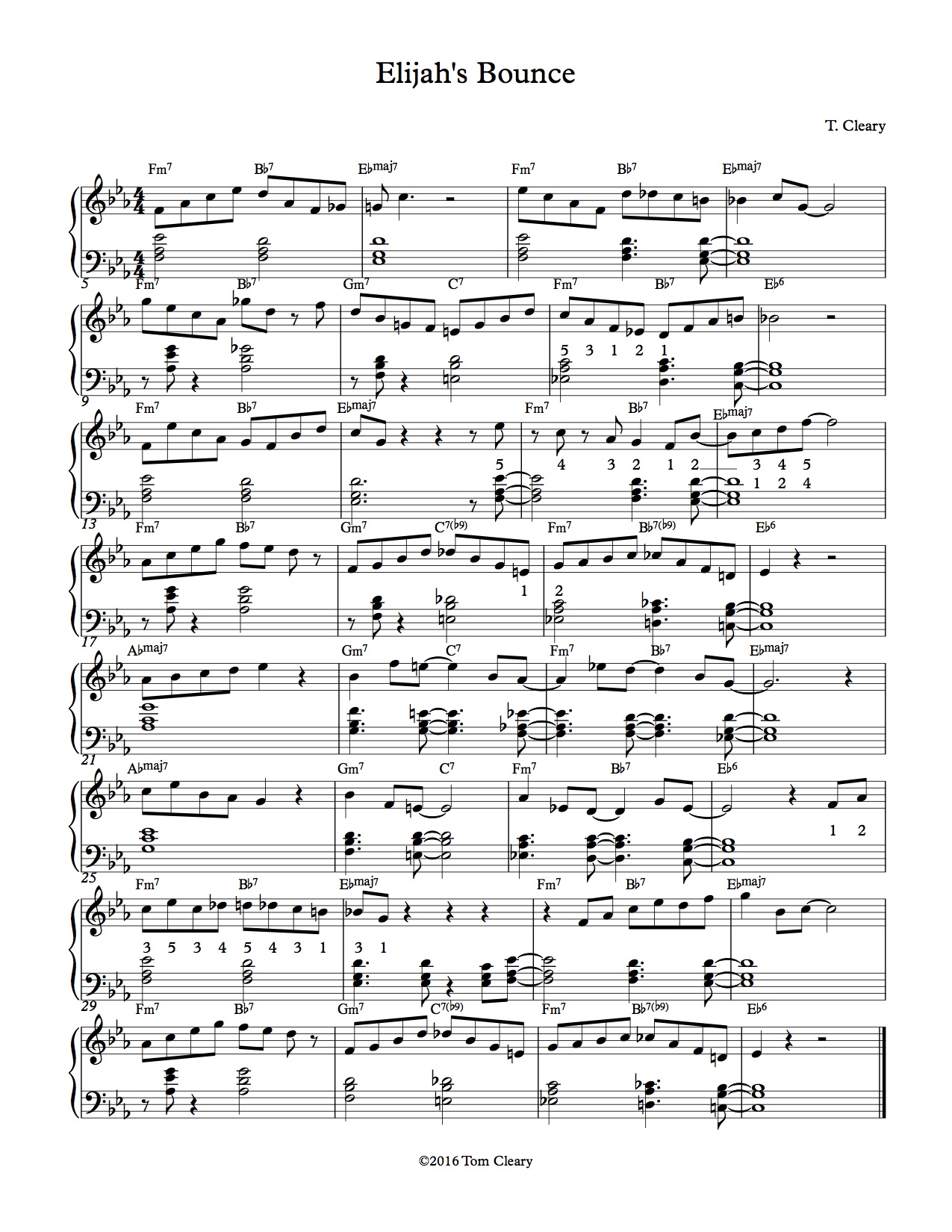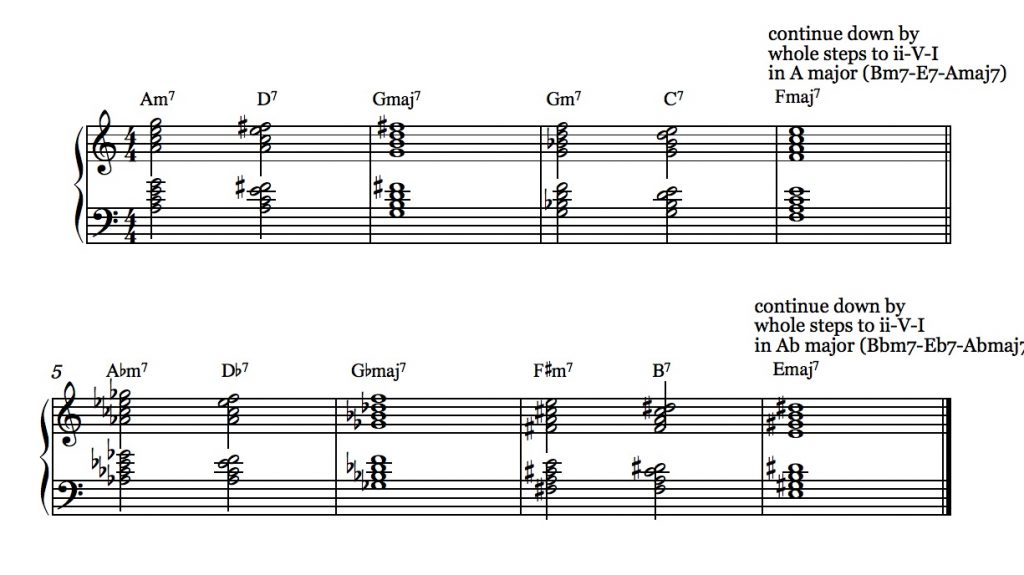This melody line combines patterns from the posts on one-bar ii-V progressions (‘Give it up for the root (position pattern)s‘ and ‘Midnight Donna and Reets in Paris‘) and with those introduced in the posts on longer ii-V-I patterns (Harmonic Moss Parts 1 and 2 and Six Degrees of Bud Powell, part ii-V-I). The written left-hand comping models the concept of creating a conversational approach to a two-chord progression by using left hand voicings as ‘bookends’ for an intervening right hand phrase, as well as the concept of using rhythmic placement of chords to accent melodic anticipations (i.e.places where the melodic line lands on the next change a half beat or more before the appearance of the chord symbol and/0r the arrival of the change in a quarter note bassline, a very common occurrence in a bop line.) A rough recording of the tune can be heard  here.
here.
Who is this guy? Click here to find out more…
The State of The Blues (solos on blues progressions)
- The State of The Blues, Part One: Helen Sung’s solo on C Jam Blues
- Talking and taking the words away: a visit from Stefon Harris (The State of the Blues, Part 2)
- State of The Blues, part 3: Joe Davidian’s solo on ‘Straight, No Chaser’
- A message from the future of jazz: Camille Thurman and her solo on ‘Sassy’s Blues’ (The State of the Blues, part four)
- An excerpt from Shirley Horn’s solo on ‘What Would A Woman Do?’ (The State of the Blues, part 5)
- The State of The Blues, Part Six: Gabrielle Stravelli’s solo on ‘Karma Medley’
- An excerpt from Harvey Diamond’s solo on ‘Tenor Madness’ (State of the Blues, Part 7)
- ‘Sideslipping’ in clave: Arturo O’Farrill’s solo on ‘Blue State Blues’ (State of the Blues, part 8)
- ‘You have to take a breath’: Bertha Hope’s inspired internal conversation (State of the Blues, part 9)
- Leading with the left: Blues solos by Tommy Flanagan and Wynton Kelly that use hand-to-hand conversation (State of the Blues, part 10)
- A swingin’ dialogue: two choruses of Emmet Cohen’s intro solo on Joe Lovano’s ‘Big Ben’ (State Of The Blues, #11)
- How Red Garland’s first chorus of solo on ‘Blues By Five’ models a number of often overlooked jazz piano techniques (State of The Blues, #12)
- ‘Thin-slicing’ the blues: Kavita Shah’s solo on ‘Interplay’ (State Of The Blues, #13)
Emulate, Assimilate, Innovate
- Emulate, Assimilate, Innovate part 1 – stepwise patterns time-traveling through music history: Mozart, Haydn and Ella Fitzgerald
- Emulate, Assimilate, Innovate, Part 2: Bud Powell and Wynton Kelly
- Emulate, assimilate, innovate, part 2a: Ella Fitzgerald and ‘The Irish Washerwoman’
- Emulate, Assimilate, Innovate, Part 3: echoes of Billy Strayhorn’s ‘Rain Check’
- Emulate, Assimilate, Innovate, part 4: Taking the fifth – melodic phrases using perfect 5ths
- The Sixth Sense: major and minor sixths in the improvising of Thelonious Monk and Ella Fitzgerald (Emulate, Assimilate, Innovate part 5)
- Sevenths reaching for the heavens (or other faraway places) (Emulate, Assimilate, Innovate part 6)
Original tunes on changes of Vermont All State Jazz Ensemble audition tunes
Harmonic Moss (rootless voicings of the ii-V and ii-V-I)
- Harmonic Moss, Part 1: The ‘A form’ voicing of the major ii-V-I (including a scale outline and related melodic patterns)
- Harmonic Moss, Part 2: The ‘B form’ voicing of the major ii-V-I (including a scale outline and various melodic patterns)
- Harmonic Moss, Part 3: Route 37, a voicing-based melodic line
- Harmonic Moss, Part 4: the ‘A’ form voicing of the minor ii-V-i progression
- Harmonic Moss, Part 5: The ‘B’ form voicing of the minor ii-V-i progression
Improvisation
- Will The Circle Be Unbroken, Part 1: the seventh scale, the circle of fifths, melodic patterns from rootless dominant 7th voicings (featuring ‘October Blues’)
- Will The Circle Be Unbroken, Part 2: an exercise and reflections on the circle of descending fifths and the dominant cycle
- ‘Making the changes’ on the blues
- Everybody’s Inside Blues: ‘making the changes’ in a blues line
- Rhythm Changes and Trading Fours
- Simple Paris Dancers: a bop-style rhythm changes
- Charlie Parker and Alan Turing: Cracking the bebop code in ‘Anthropology’
- One half step of separation: Miles Davis and Ray Vega (a.k.a. the half step between the root and the seventh in the seventh scale)
- ‘Now What?’: a modal melody collage
- Midnight Donna and Reets in Paris: anagrams, mirrors and the one bar ii-V
- Six Degrees of Bud Powell, Part ii-V-I
- The neighborhood hang and the history hang (including ‘Monk, Bud and Elmo’, a tune on the changes of ‘In Walked Bud’)
- ‘Ornithology’: the memory palace of two bebop masterminds
- What is this scale called: Charlie Parker, Barry Harris and the minor ii-V progression
Root Systems (root position voicings)
- Root Systems, Part 1: Join the ii-V-I Club
- Root systems, part 2 / Take three at a time: an approach to learning major scales and ii-V-I progressions in all keys along with tunes from The Real Book (Volume I, sixth edition)
- Root systems, part 3 / outlining the ii-V and ii-V-I progressions with 7-up scales
- Root systems, part 4: Give it up for the root (position pattern)s! – Melodic patterns based on root position voicings
- Root systems, part 5 / Elijah’s Bounce
Pairings (jazz and classical pieces)
- Pairings, part one: left-hand walking bass and right hand lines in Dave McKenna, Bach and Handel
- Pairings, part two: left hand walking bass with right hand chordal comping by Kenny Barron, John Coates Jr. and G.F. Handel (or, Spring Comping Trip)
- Pairings, part three – Hand-some conversation: Two-handed melodic conversations by J.S. Bach and Oscar Peterson
- Sonatinas and other two-sided stories
- Look who’s Bartok-in’: folk song reinvention from Bela Bartok to Chick Corea and beyond
Conversation Pieces
Comping Trips (examples of comping by great jazz pianists)
One, Two and Three Chord Tunes (New Orleans jazz standards)
Various Other Posts
-
Recent Posts
- Emulate, assimilate, innovate, part 2a: Ella Fitzgerald and ‘The Irish Washerwoman’
- How to write a two-bar blues (featuring an original blues, ‘After Lunch’)
- The Magic Number: great three-chorus solos on the ‘jazz blues’ progression, with an original tune, ‘Notes From All Over’
- What Do You Do With Two? – Great two-chorus solos on the jazz blues progression
- ‘Thin-slicing’ the blues: Kavita Shah’s solo on ‘Interplay’ (State Of The Blues, #13)
Recent Comments
- Abby Marks on One Time Only (in memory of Ellen Powell, with a short history of the progression to ‘There Will Never Be Another You’)
- Corby Guba on Emulate, Assimilate, Innovate, part 4: Taking the fifth – melodic phrases using perfect 5ths
- Hunter Sarkis on American Tunes
- Corby Guba on A menagerie of intervals
- tgcleary on The Magic Number: great three-chorus solos on the ‘jazz blues’ progression, with an original tune, ‘Notes From All Over’
Archives
- January 2024
- December 2023
- October 2023
- September 2023
- August 2023
- July 2023
- April 2023
- March 2023
- October 2022
- September 2022
- April 2022
- February 2022
- December 2021
- November 2021
- October 2021
- April 2021
- March 2021
- February 2021
- January 2021
- August 2020
- June 2020
- May 2020
- March 2020
- February 2020
- December 2019
- November 2019
- October 2019
- September 2019
- July 2019
- June 2019
- April 2019
- March 2019
- February 2019
- January 2019
- October 2018
- July 2018
- March 2018
- February 2018
- January 2018
- November 2017
- June 2017
- May 2017
- April 2017
- March 2017
- February 2017
- January 2017
- December 2016
- November 2016
- October 2016
- August 2016
- June 2016
- March 2016
- February 2016
- January 2016
- November 2015
- July 2015
- April 2015
- March 2015
- February 2015
- August 2014
- May 2014
- April 2014
- March 2014
- January 2014
- November 2013
- August 2013
- July 2013
- June 2013
- March 2013
- February 2013
- January 2013
- January 2012
Categories
Meta
- January 2024
- December 2023
- October 2023
- September 2023
- August 2023
- July 2023
- April 2023
- March 2023
- October 2022
- September 2022
- April 2022
- February 2022
- December 2021
- November 2021
- October 2021
- April 2021
- March 2021
- February 2021
- January 2021
- August 2020
- June 2020
- May 2020
- March 2020
- February 2020
- December 2019
- November 2019
- October 2019
- September 2019
- July 2019
- June 2019
- April 2019
- March 2019
- February 2019
- January 2019
- October 2018
- July 2018
- March 2018
- February 2018
- January 2018
- November 2017
- June 2017
- May 2017
- April 2017
- March 2017
- February 2017
- January 2017
- December 2016
- November 2016
- October 2016
- August 2016
- June 2016
- March 2016
- February 2016
- January 2016
- November 2015
- July 2015
- April 2015
- March 2015
- February 2015
- August 2014
- May 2014
- April 2014
- March 2014
- January 2014
- November 2013
- August 2013
- July 2013
- June 2013
- March 2013
- February 2013
- January 2013
- January 2012
